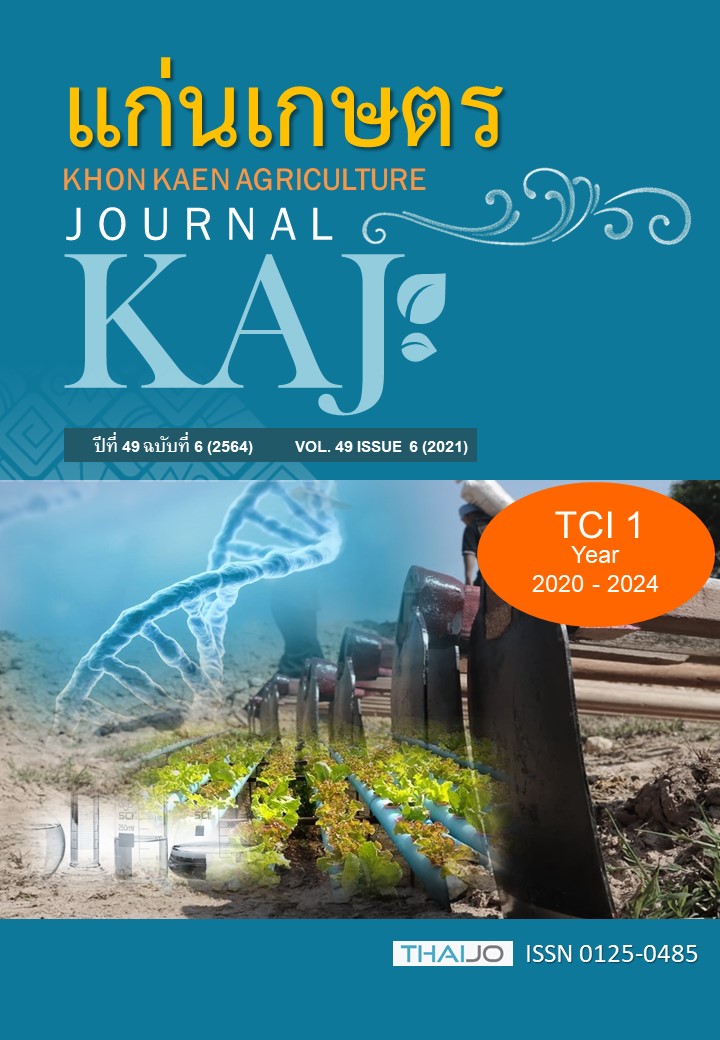ผลของสารจิบเบอเรลลินและบราสสิโนสเตียรอยด์ต่อการสร้างปมไรโซเบียมการเจริญเติบโต และผลผลิตเมล็ดพันธุ์ถั่วเหลืองสายพันธุ์ก้าวหน้าที่ปลูกในฤดูแล้งหลังนา
Main Article Content
บทคัดย่อ
การคลุกเมล็ดและการพ่นสารจิบเบอเรลลิน (GA3) และบราสสิโนสเตียรอยด์ (EBL) สามารถกระตุ้นความงอกและการเจริญเติบโตของถั่วเหลืองภายใต้สภาพอุณหภูมิต่ำ การศึกษาในครั้งนี้จึงมีวัตถุประสงค์เพื่อประเมินผลของสาร GA3 และ EBL ต่อการสร้างปมไรโซเบียม การเจริญเติบโต และผลผลิตเมล็ดพันธุ์ถั่วเหลืองสายพันธุ์ CM0701-24 พบว่า การคลุกเมล็ดพันธุ์ถั่วเหลืองด้วยสาร GA3 และ EBL ที่ใส่เชื้อไรโซเบียมชนิด Bradyrhizobium japonicum (USDA 110) ทำให้มีจำนวนและน้ำหนักสดของปมไรโซเบียม และปริมาณการดูดใช้ไนโตรเจนทั้งหมดของถั่วเหลืองเพิ่มขึ้น การคลุกเมล็ดพันธุ์ถั่วเหลืองด้วยสาร GA3 100 ppm สาร EBL 0.50 ppm และสาร GA3 50 ppm ร่วมกับสาร EBL 0.25 ppm มีผลทำให้ความงอกในไร่เพิ่มขึ้นและเวลาเฉลี่ยในการงอกลดลงภายใต้สภาวะอุณหภูมิต่ำ การคลุกเมล็ดพันธุ์ถั่วเหลืองด้วยสาร GA3 50 ppm ร่วมกับสาร EBL 0.25 ppm ก่อนปลูก ตามด้วยการพ่นสาร GA3 100 ppm ที่ระยะออกดอก (R1) ทำให้ผลผลิตเมล็ดพันธุ์ถั่วเหลืองเพิ่มขึ้น เมื่อเปรียบเทียบกับการคลุกและไม่คลุกสารทุกกรรมวิธีร่วมกับการพ่นสารด้วยน้ำกลั่น
Article Details

อนุญาตภายใต้เงื่อนไข Creative Commons Attribution-NonCommercial-NoDerivatives 4.0 International License.
เอกสารอ้างอิง
กรมวิชาการเกษตร. 2547. เอกสารวิชาการการปลูกพืชไร่. สถาบันวิจัยพืชไร่ กรมวิชาการเกษตร, กรุงเทพฯ.
กรมอุตุนิยมวิทยา. 2561. สถิติภูมิอากาศคาบ 30 ปี พ.ศ. 2524-2553. แหล่งข้อมูล: http://climate.tmd.go.th/statistic/stat30y. ค้นเมื่อ 13 กรกฎาคม 2562.
กองวิจัยพัฒนาเมล็ดพันธุ์พืช. 2563. โครงการวิจัยและผลิตเมล็ดพันธุ์พืชตระกูลถั่ว (ถั่วเหลือง ถั่วเขียว และถั่วลิสง) คุณภาพดีเพื่อรองรับการผลิตพืชภายใต้วิกฤตภัยแล้ง. แหล่งข้อมูล: http://me.doa.go.th/research/researchview.php?showdetail=&id=154. ค้นเมื่อ 16 มีนาคม 2563.
กัณทิมา ทองศรี, จุฑามาศ ร่มแก้ว, จวงจันทร์ ดวงพัตรา และกนกวรรณ เที่ยงธรรม. 2562ก. ผลของสารควบคุมการเจริญเติบโตของพืชต่อคุณภาพเมล็ดพันธุ์ถั่วเหลืองภายใต้สภาวะอุณหภูมิต่ำ. น. 85-98. ใน: การประชุมทางวิชาการเมล็ดพันธุ์พืชแห่งชาติ ครั้งที่ 16 18-21 มิถุนายน 2562. สมาคมเมล็ดพันธุ์แห่งประเทศไทย, กรุงเทพฯ.
กัณทิมา ทองศรี, ภภัสสร วัฒนกุลภาคิน, ศุภลักษ์ สัตยสมิทสถิต และฉันทนา คงนคร. 2562ข. การใช้สารบราสสิโนสเตียรอยด์ต่อผลผลิตและคุณภาพเมล็ดพันธุ์ถั่วเหลืองในสภาวะแห้งแล้ง. น. 200-210. ใน: การประชุมทางวิชาการพืชวงศ์ถั่วแห่งชาติ ครั้งที่ 7 6-8 สิงหาคม 2562. กรมวิชาการเกษตร, กรุงเทพฯ.
จวงจันทร์ ดวงพัตรา. 2529. เทคโนโลยีเมล็ดพันธุ์. พิมพ์ครั้งที่ 2. กลุ่มหนังหนังสือเกษตร, กรุงเทพฯ.
อ้อยทิน ผลพานิช, วิระศักดิ์ เทพจันทร์, รัชนี โสภา และสิทธิ์ แดงประดับ. 2558 การปรับปรุงพันธุ์ถั่วเหลืองเพื่อผลผลิตสูงในแต่ละพื้นที่ (ชุดที่ 2). แหล่งข้อมูล: http://www.doa.go.th/research/attachment.php?aid=2098. ค้นเมื่อ 13 กรกฎาคม 2562.
สถาบันวิจัยพืชไร่. 2537. การผลิตเมล็ดพันธุ์หลักพืชไร่. โรงพิมพ์คุรุสภาลาดพร้าว, กรุงเทพฯ.
Bremner, J.M. 1960. Determination of nitrogen in soil by the Kjeldahl method. The Journal of Agricultural Science. 55(1): 11-33.
Broughton, W.J., and M.J. Dilworth. 1971. Control of leghemoglobin synthesis in snake beans. Biochemical Journal. 125(4): 1075-1080.
Caesar, K., K. Elgass, Z. Chen, P. Huppenberger, J. Witthoft, F. Schleifenbaum, M.R. Blatt, C. Oecking, and K. Harter. 2011. A fast brassinolide-regulated response pathway in the plasma membrane of Arabidopsis thaliana. The Plant Journal. 66(3): 528-540.
Davies, P.J. 1995. The plant hormone concept: concentration, sensitivity and transport. P. 13-38. In: P.J. Davies. Plant hormones physiology, biochemistry and molecular biology. Section of plant biology, Division of biological sciences, Cornell University, Ithaca, USA.
Divi, U.K., and P. Krishna. 2009. Brassinosteroid: a biotechnological target for enhancing crop yield and stress tolerance. New Biotechnology. 26(3-4): 131-136.
Eiichi, T. 2005. Regulation of root growth by plant hormones roles for auxin and gibberellin. Critical Reviews in Plant Sciences. 24(4): 249-265.
Ellis, R.H., and E.H. Roberts. 1981. The quantification of ageing and survival in orthodox seeds. Seed Science and Technology. 9(2): 373-409.
Ferguson, B., and U. Mathesius. 2003. Signaling interactions during nodule development. Journal of Plant Growth Regulation. 22: 47–72.
Ferguson, B.J., J.J. Ross, and J.B. Reid. 2005. Nodulation phenotypes of gibberellin and brassinosteroid mutants of Pisum sativum. Plant Physiology. 138: 2396-2405.
Gupta, R., and S.K. Chakrabarty. 2013. Gibberellic acid in plant: Still a mystery unresolved. Plant Signaling & Behavior. 8(9): e25504.
Herner, R.C. 1990. The effects of chilling temperatures during seed germination and early seedling growth. P.51-69. In: C.Y. Wang. Chilling Injury of Horticultural Crops. CRC Press.
Jomol, P.M., S.J. Herbert, S.Z. Andreas, A.F. Rautenkranz, and G.V. Litchfield. 2000. Differential response of soybean yield components to the timing of light enrichment. Agronomy Journal. 92(6): 1156-1161.
Leubner-Metzger G. 2001. Brassinosteroids and gibberellins promote tobacco seed germination by distinct pathways. Planta. 213(5): 758-763.
Li, X., J. Cai, D. Jiang, H. Jiang, T. Dai, F. Liu, and W. Cao. 2013. Induction of chilling tolerance in wheat during germination by pre-soaking seed with nitric oxide and gibberellin. Plant Growth Regulation. 71(1): 31-40.
Méndez, C., C. Baginsky, P. Hedden, F., Gong, M. Carú, and M.C. Rojas. 2014. Gibberellin oxidase activities in Bradyrhizobium japonicum bacteroids. Phytochemistry. 98: 101-109.
Morillon, R., M. Catterou, R.S. Sangwan, B.S. Sangwan, and J.P. Lassalles. 2001. Brassinolide may control aquaporin activities in Arabidopsis thaliana. Planta. 212(2): 199-204.
R Core Team. 2020. R: A language and environment for statistical computing. R Foundation for Statistical Computing, Vienna, Austria.
Sarkar, P.K., M.S. Haque, and M.A. Karim. 2002. Effects of GA3 and IAA and their frequency of application on morphology, yield contributing characters and yield of soybean. Pakistan Journal of Agronomy. 1: 119-122.
Szekeres, M., K. Nemeth, Z. Koncz-Kalman, J. Mathur, A. Kauschmann, T. Altmann, G.P. Redei, F. Nagy, J. Schell, and C. Koncz. 1996. Brassinosteroids rescue the deficiency of CYP90, a cytochrome P450, controlling cell elongation and de-etiolation in Arabidopsis. Cell. 85(2): 171-182.
Wang, Q., Z. Feng, and D.L. Smith. 1996. Application of GA3 and kinetin to improve corn and soybean seedling emergence at low temperature. Environmental and Experimental Botany. 36(4): 377-383.
Wei, Z., and J. Li. 2016. Brassinosteroids regulate root growth, development, and symbiosis. Molecular Plant. 9(1): 86-100.
Yamaguchi, S. 2008. Gibberellin metabolism and its regulation. Annual Review of Plant Biology. 59: 225-251.
Yuan, L., and D.Q. Xu. 2001. Stimulation effect of gibberellic acid short-term treatment on the photosynthesis related to the increase in rubisco content in broad bean and soybean. Photosynthesis Research. 68: 39-47.
Zhang, F., B. Pan, and D.L. Smith. 1997. Application of gibberellic acid to the surface of soybean seed (Glycine max (L.) Merr.) and symbiotic nodulation, plant development, final grain and protein yield under short season conditions. Plant and Soil. 188: 329-335.
Zhang, M.C., Z.X. Zhai, X.L. Tian, L.S. Duan, and Z.H. Li. 2008. Brassinolide alleviated the adverse effect of water deficits on photosynthesis and the antioxidant of soybean (Glycine max L.). Plant Growth Regulation. 56: 257-264.
Zheng, C., D. Jiang, F. Liub, T. Dai, W. Liu, Q. Jing, and W. Cao. 2009. Exogenous nitric oxide improves seed germination in wheat against mitochondrial oxidative damage induced by high salinity. Environmental and Experimental Botany. 67(1): 222-227.


